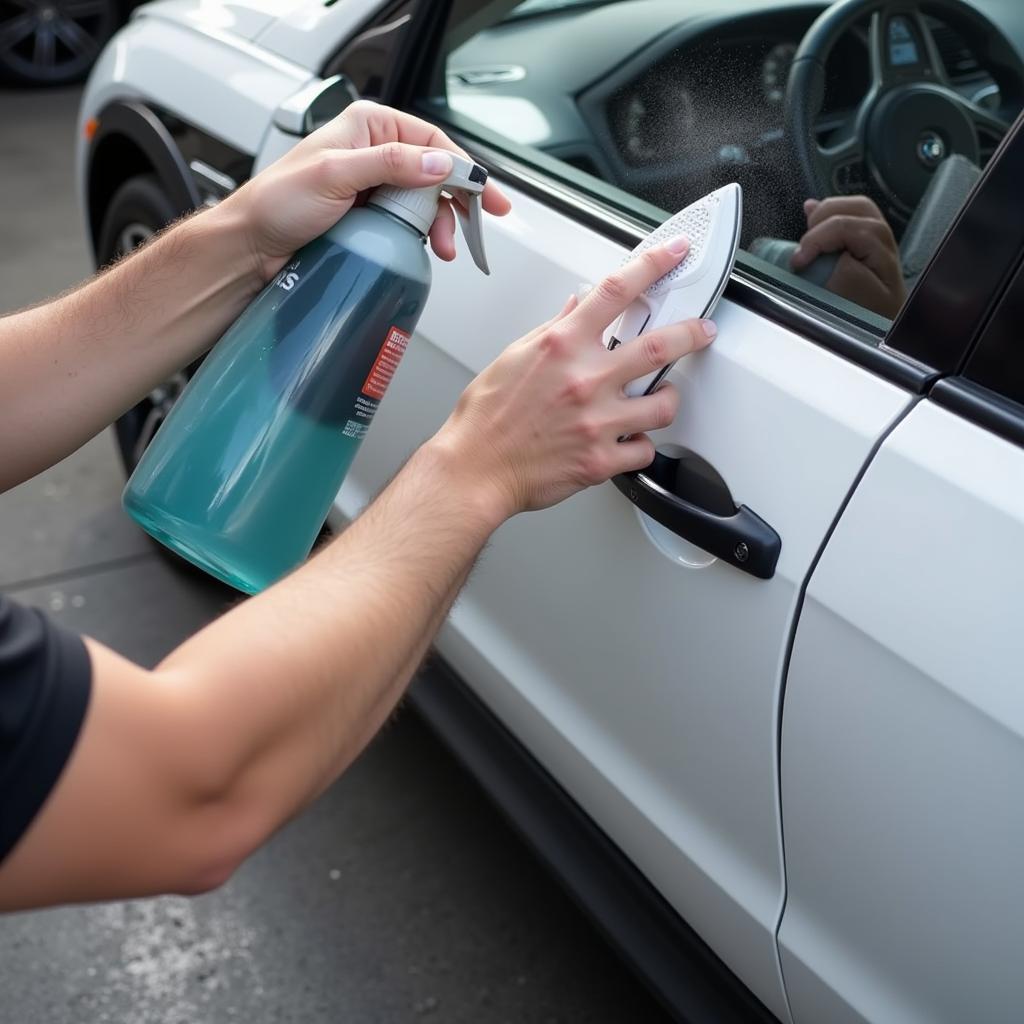Graystone, in the world of car detailing, refers to a specific type of contamination that can plague your vehicle’s paint. It’s not as commonly discussed as swirl marks or water spots, but understanding what graystone is and how to deal with it is crucial for achieving a truly pristine finish. It’s a silent enemy that can dull your paint and make it feel rough to the touch.
Decoding the Mystery of Graystone Contamination
Graystone isn’t a single substance, but rather a collection of embedded contaminants that bond with the clear coat of your car. These contaminants can include industrial fallout, brake dust, metallic particles, tree sap, and even remnants of insect splatter. Over time, these particles become embedded in the paint’s pores, creating a rough texture and a dull, grayish appearance, hence the name “graystone.” This contamination can be particularly noticeable on lighter colored vehicles.
What makes graystone particularly challenging is its tenacity. Regular washing often fails to remove it, and it can even resist some less aggressive polishing methods. This is because the contaminants are physically bonded to the clear coat, requiring specialized methods for removal.
Why is Removing Graystone Important?
Beyond the aesthetic impact, graystone can have detrimental effects on your car’s paint in the long run. The embedded contaminants can act as abrasive particles, increasing the risk of swirl marks and scratches during washing. Furthermore, graystone can interfere with the bonding of waxes and sealants, reducing their effectiveness and longevity. This means less protection for your paint against the elements and more frequent detailing sessions.
How to Identify Graystone on Your Car
Identifying graystone requires a keen eye and the right conditions. Often, it’s easier to spot in direct sunlight or under bright artificial lighting. Run your hand across the paint’s surface. If it feels rough or gritty, even after a wash, it’s a strong indication of graystone contamination. Another telltale sign is a hazy or dull appearance, especially on lighter colored cars. Look closely for tiny, embedded particles that appear darker than the surrounding paint.
Effective Methods for Graystone Removal
Successfully removing graystone involves a two-step process: chemical decontamination and mechanical decontamination.
Chemical Decontamination
This process involves using specialized car detailing products like iron removers and fallout removers. These products chemically react with the metallic particles and other contaminants, breaking down their bond with the clear coat. This makes them easier to rinse away.
 Applying iron remover to car paint for chemical decontamination
Applying iron remover to car paint for chemical decontamination
Mechanical Decontamination
After the chemical treatment, a clay bar or a clay mitt can be used to physically lift and remove the loosened contaminants. This process involves lubricating the paint surface and gently gliding the clay bar or mitt across it. The clay acts like a magnet, picking up any remaining embedded particles. This process also smooths the paint surface, restoring its gloss and slickness.
what is the meaning of clay detailing in car wash
Preventing Graystone Buildup
While completely preventing graystone is impossible, you can significantly reduce its accumulation through regular maintenance. Frequent washing, especially after driving in areas with high industrial activity or near construction sites, can help prevent contaminants from embedding themselves in the paint. Applying a high-quality car wax or sealant can also create a protective barrier, making it more difficult for contaminants to bond with the clear coat.
what is graystone product in car detailing
What Products Should I Use?
Choosing the right products for graystone removal is crucial for effective results and preventing damage to your car’s paint.
what to buy to professional wash and detail car
“Remember,” advises renowned detailing expert, Michael Davies, “prevention is always better than cure. Regular maintenance washes and the use of protective sealants are your best defense against the damaging effects of graystone.”
Conclusion
Understanding what graystone is and how to address it is a vital part of maintaining your car’s appearance and protecting its paint. By incorporating regular decontamination into your detailing routine, you can ensure your vehicle’s paint remains smooth, glossy, and free from the dulling effects of embedded contaminants. Don’t let graystone diminish your car’s shine – take action and keep it looking its best.
FAQ
- What is graystone? Graystone is a type of contamination caused by embedded particles on car paint.
- How do I know if my car has graystone? The paint will feel rough and look dull, especially in direct light.
- How do I remove graystone? Use a combination of chemical decontamination (iron remover) and mechanical decontamination (clay bar).
- Can I prevent graystone? Regular washing and applying sealant can help minimize graystone buildup.
- What causes graystone? Industrial fallout, brake dust, tree sap, and insect remnants are common causes.
- Why is it important to remove graystone? It can damage the paint, making it more susceptible to scratches.
- Is graystone removal expensive? Not necessarily. DIY methods can be affordable with the right products.
Need assistance? Contact us via WhatsApp: +1(641)206-8880 or Email: [email protected]. Our 24/7 customer service team is ready to help.

Leave a Reply